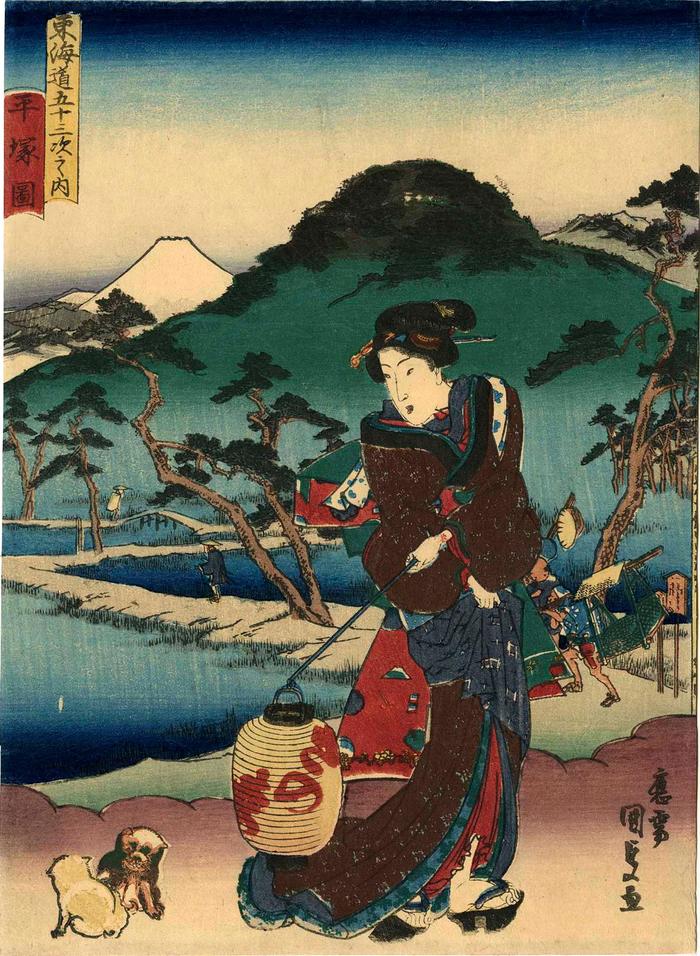Utagawa Kunisada (歌川国貞) / Toyokuni III (三代豊国) (artist 1786 – 01/12/1865)
View of Hiratsuka (Hiratsuka no zu: 平塚図) from the series Fifty-three Stations of the Tōkaidō Road (Tōkaidō gojūsan tsugi no uchi: 東海道五十三次之内)
ca 1838
Signed: ōju Kunisada (応需国貞)
Publisher: Sanoya Kihei
Censor's seal: kiwame
Museum of Fine Arts, Boston
National Diet Library
Museum für angewandte Kunst, Vienna
British Museum - Hiroshige's 'Hiratsuka Nawate-michi' version
Ishikawa Prefectural Museum of Art - they date their copy to 1836
Bryn Mawr
Honolulu Museum of Art
The Spencer Museum of Art
Fujisawa Ukiyo-e Museum
Victoria and Albert Museum
Nelson-Atkins Museum of Art All of the prints in this series are chūban sized. The example of this print in the collection of the Museum of Fine Arts in Boston is 9 3/8 × 7 3/16 in. This one in the Lyon Collection is approximately the same size. The one in Boston has been trimmed slightly at the top while the print in the Lyon Collection has been cut down slightly along the left side.
****
Hiratsuka is 7 miles from Fujisawa. Kunisada's version of this print differs from Hiroshige's in several ways: Kunisada has moved the location of Mt. Fuji in the distance and in the Hiroshige is an image of a mail carrier (a hikyaku or 'flying foot') who speeding along the road. There were three categories of these carriers: one for the bakufu who could make the whole journey in about 2½ days, a daimyo class, and lastly a merchant mail carrier who would make the trip in about a week for a fee.
This is the eighth print in this series. The curatorial files at the Museum für angewandte Kunst in Vienna say: "The representation is similar to that of Hiroshige, but Kunisada has designed the mountain and hill landscape in the background differently. On the way he left out the runner with the express mail and added a litter holder in another place. In the foreground a woman with a lantern in her hand, on which there are the characters "sa さ -no の -ki 喜" for the publisher Sanoya Kihei 佐野 屋兵衛. Next to her two small dogs." Notice also the placement of Mt. Fuji in the distance. In the Kunisada we see it on the left-hand side. In the Hiroshige the mountain is to the right of the large hill behind the bijin.
****
Gian Carlo Calza in his description in Hiroshige: The Master of Nature of the original Hiroshige print re-imagined in this scene said: "While the daimyō's procession might take more than a month to travel the Tōkaidō between Edo and Miyako, messages and parcels travelling with relay runners between the post stations could cover the distance in less than five days, travelling one hundred kilometres or more each day. This print shows a relay runner passing by two palanquin carriers returning to the base after leaving their client at his destination. Mount Koma stands in the background, and further off, the snowy peak of Mount Fuji." The runner in this print in the Lyon Collection is obscured by the figure of the bijin in the foreground.
****
In Tokaido Landscapes: The Path from Hiroshige to Contemporary Artists, 2011, #8, p. 20, speaking of the original Hiroshige print, the second example shown above to the left, it says in a text by Sasaki Moritoshi: "The road becomes a footpath through rice paddies as it heads toward Ōiso. A pair of palanquin bearers and a courier cross paths by signpost marking the western end of he Hiratsuka station. The path's zigzag leads one's eye to the rounded slopes of Komayama. The angular mountain to the right is Ōyama, which is famous for religious worship. A snow-covered Mount Fuji is also visible inthe distance."
****
In Hiroshige: l'art du voyage, Paris, 2012, p. 60 it identifies the rounded 'mountain' in the center of the print as Mount Kōrai.
****
In Masterworks of Ukiyo-e: Hiroshige, the 53 Stations of the Tōkaidō by Muneshige Narazaki. 1969, p. 36 it says: "This particular scene has changed very little since Hiroshige's day. In autumn, one will see the same maple trees on the hill - now called Kōraizan - turning red and yellow. It was not in Hiroshige's nature to falsify a scene, however familiar, or even hackneyed, it may have become. The ancient name of the locality, Morokoshigahara [もろこしが原] (which means "fields of China"), appears in the diary of a thirteen-year-old girl, written in the year 1020, who records her astonishment at seeing Japanese wild pinks blooming in a field with a Chinese name."
****
There is a Hokusai surimono in the collection of the British Museum. It has an inscription which reads: "咲ミたる梅かかん家や春風に匂ひのわたるもろこしか原". The transliteration is: "Sakimidaru / ume ga Kanke ya / harukaze ni / nioi no wataru / Morokoshigahara." The translation followed by explications: "Morokoshigahara, / where the scent of the wildly / blossoming plum / travels abroad on the spring winds, / like Sugawara Michizane." "The poem is an example of complex wordplay. 'Kanke' is another name for Sugawara Michizane, but the first syllable 'ka' also connects with the previous words 'ume ga' to make the phrase 'ume ga ka' (scent of plum blossom). 'Wataru' is the word used to indicate Michizane's going abroad to China, but also can suggest 'widely dispersed.' Michizane is said to have travelled to China on the wind. Morokoshigahara, a remote place in central Japan, is introduced here mainly because Morokoshi is a Japanese name for China."
****
Illustrated in a small color reproduction in Kunisada's Tokaido: Riddles in Japanese Woodblock Prints by Andreas Marks, Hotei Publishing, 2013, page 64, T24-08.
Sanoya Kihei (佐野屋喜兵衛) (publisher)
landscape prints (fūkeiga 風景画) (genre)
beautiful woman picture (bijin-ga - 美人画) (genre)
